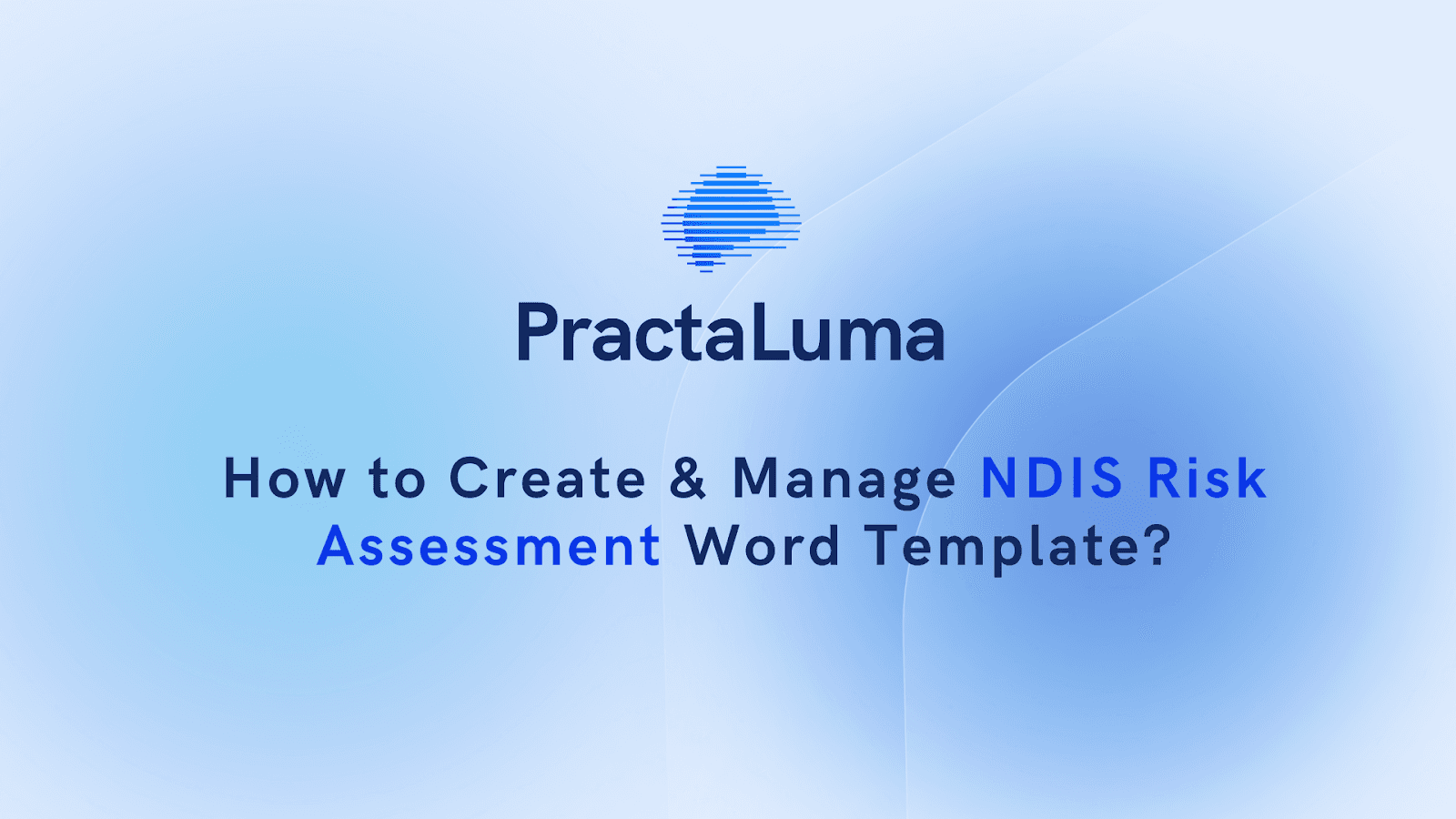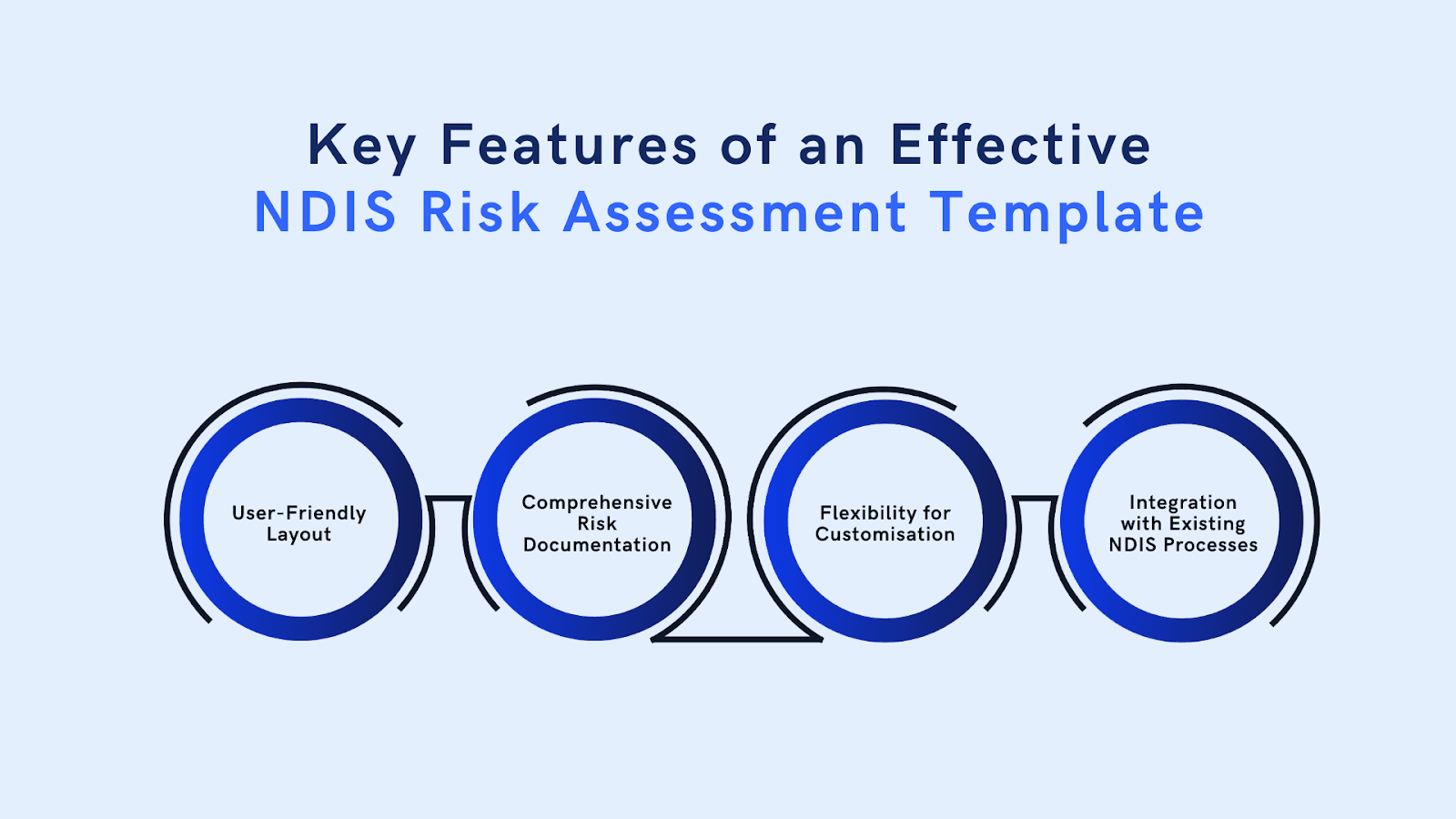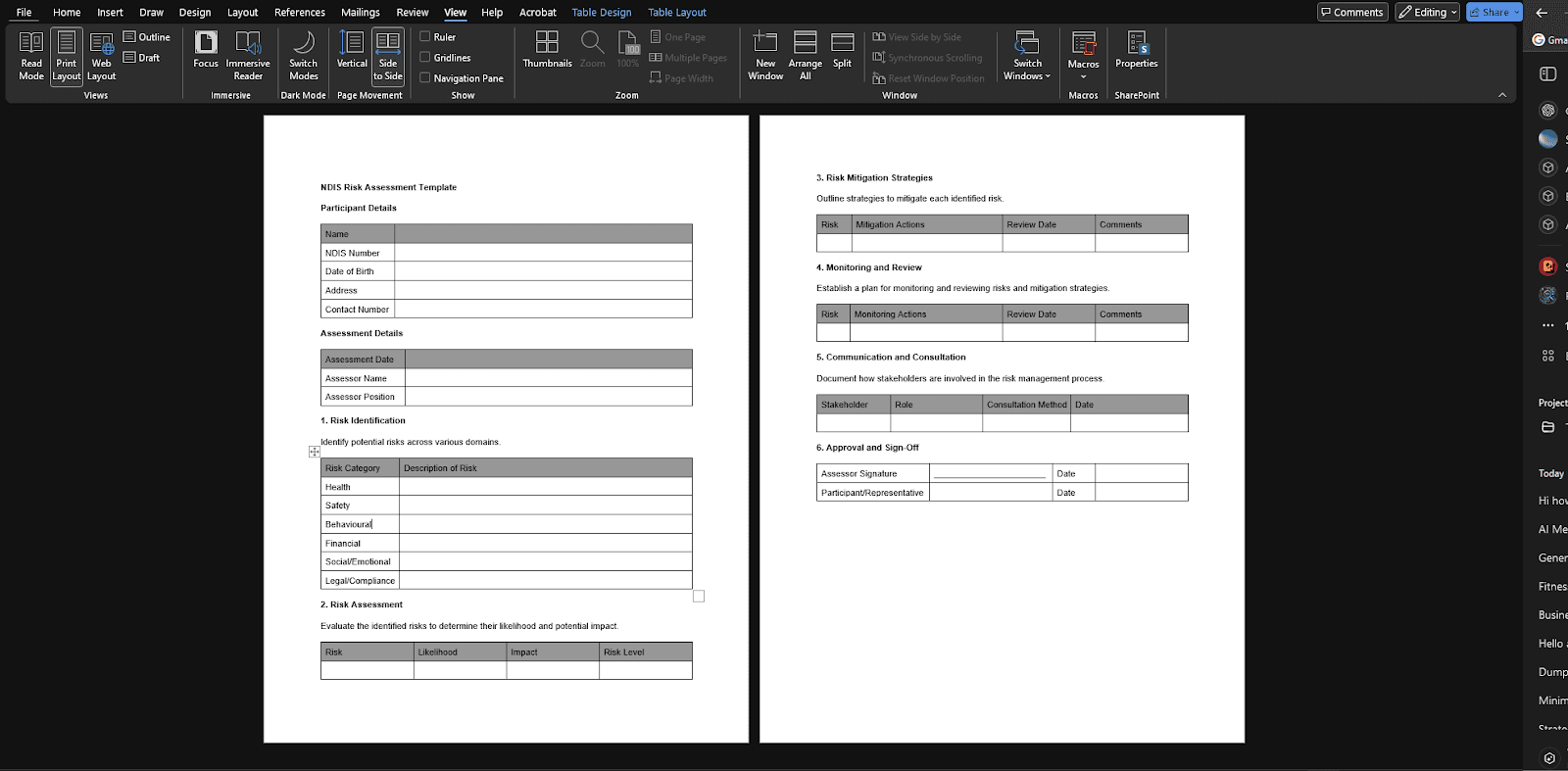
19 March 2025
How to Create & Manage NDIS Risk Assessment Word Template?
The National Disability Insurance Scheme (NDIS) always prioritises patient safety and quality of care and offers substantial support to healthcare professionals.
The purpose of NDIS is to provide funding and support to individuals with permanent and significant disabilities to enhance their independence, access to community resources, and overall quality of life.
By offering clear guidelines and resources, the NDIS assists healthcare professionals in conducting thorough risk assessments that align with the NDIS Practice Standards, ensuring compliance with legal and ethical requirements. This collaboration empowers patients to take informed risks while maintaining their independence—a cornerstone of the NDIS vision.
In this blog, we will discuss a key aspect of the NDIS framework, a few risk assessment templates and how to manage them. Before we jump right in, let’s explore the importance of a comprehensive NDIS Risk Assessment template.
Importance of NDIS Risk Assessment Templates
According to a 2024 report from the Australian Institute of Health and Welfare (AIHW), in the 2023–24 period, the NDIS Quality and Safeguards Commission received 111,345 complaints, showing a 78.2 percent increase in complaints and a 47.3 percent increase in reportable incidents. This highlights the need for robust risk management tools.
Risk management is essential in the NDIS sector for ensuring the safety and well-being of people with disabilities. However, identifying and managing risks can be a complex and time-consuming process, especially when you are juggling multiple tasks. That's where a well-structured NDIS Risk Assessment Template comes into play.
“An NDIS Risk Assessment Template is a structured tool designed to help NDIS providers systematically identify, assess, and manage potential risks related to the safety and well-being of people with disabilities.” These templates provide a clear framework for evaluating hazards, determining their impact, and implementing necessary control measures to minimise risks.
A template ensures consistency and helps teams maintain compliance with NDIS guidelines by providing a systematic approach to documenting, assessing, and mitigating risks. Let’s explore the key components of an NDIS Risk Assessment Template and how it can significantly enhance your risk management practices.
Components of an NDIS Risk Assessment Template
A well-designed NDIS risk assessment template includes several key components to ensure thorough risk identification and effective mitigation strategies. Here are the essential sections:
1. Identifying Risks
Mental health clinicians in the NDIS must identify risks to participant safety and service delivery. These include medical emergencies, medication errors, service disruptions, environmental hazards, and challenging behaviors. Risks related to cultural or communication barriers should also be considered. Early identification helps mitigate threats and ensures safe, effective care.
2. Assessing Risk Levels
Once you’ve identified risks, the next step is to evaluate their potential impact. Using a risk matrix, you can assess each risk’s likelihood and severity to prioritise them effectively. This helps you and your team focus on the most critical risks, ensuring a proactive approach to risk management.
3. Risk Mitigation Strategies
To safeguard patients and staff, you need clear mitigation strategies. Your template should include actionable steps such as implementing safety measures, organising training programs, or establishing emergency response protocols. Assigning responsibility for these strategies ensures they are effectively carried out.
4. Monitoring and Reviewing Risks
Risk management doesn’t stop at identification. Regularly monitoring risks helps you determine if mitigation strategies are effective and spot new or evolving threats. Your template should include a section for tracking changes, reviewing outcomes, and making necessary adjustments. This keeps your practice aligned with safety and compliance standards.
To ensure your risk assessment template is effective, it should be customised to your practice's specific needs, moving beyond a basic checklist. Let's explore the key features that will enhance the effectiveness of your NDIS risk assessment template.
Key Features of an Effective NDIS Risk Assessment Template

A successful NDIS risk assessment template is more than just a checklist; it should be comprehensive, adaptable, and easy to use. Here are the key features:
1. User-Friendly Layout
The template should be easy to navigate, with clearly labelled sections and intuitive design elements like checkboxes, drop-down menus, or tables. A straightforward layout ensures risk assessments are conducted efficiently and accurately, requiring minimal training.
2. Comprehensive Risk Documentation
Each risk should be documented with a description, risk level assessment, and corresponding mitigation strategy. This ensures that every potential hazard is properly accounted for and actioned, maintaining high standards of care and safety.
3. Flexibility for Customisation
Since every NDIS provider and patient may have unique needs, the template should be flexible enough to accommodate custom risk categories or additional fields. This adaptability ensures the template remains relevant to your specific operations.
4. Integration with Existing NDIS Processes
The template should align with the broader NDIS framework and easily integrate into existing workflows, such as reporting, compliance checks, and service delivery protocols. Seamless integration ensures the risk assessment process is efficient and compliant.
With these features, the NDIS risk assessment template can be tailored to fit your organisation’s needs, driving better outcomes for patients and staff. Let’s now look at creating a risk assessment template in Word, an accessible and versatile platform.
Creating an NDIS Risk Assessment Template in Microsoft Word
Microsoft Word provides a simple yet effective platform for creating custom NDIS risk assessment templates. Here’s how to create one:
1. Setting Up the Document
Start by creating a new document with standard settings (A4 paper size, clear fonts such as Arial or Calibri, and easy-to-read font sizes). Structure the document with headings for each section (e.g., “Risk Identification,” “Risk Assessment,” “Mitigation Strategies”).
2. Utilising Word’s Features for Template Creation
Use tables to organise information such as risk descriptions, severity levels, and mitigation plans. Add drop-down lists or checkboxes for ease of use. Use consistent formatting styles (bold headings, italics for emphasis) to make the document visually clear.
3. Formatting Tips for Clarity and Usability
To enhance clarity, include bullet points for risk categories, use bold or colour coding to highlight different risk levels (low, medium, high), and ensure there is sufficient space for additional notes or comments. Keep margins aligned and use numbered lists for easy reference.
By following these steps, you can create a user-friendly and professional risk assessment template that improves efficiency and accuracy in your risk management processes.

Additionally, platforms like PractaLuma, could be a valuable tool for documenting and organising all your patient information related to risk assessments, progress notes, and patient outcomes, which are crucial in the NDIS context. Check out a trial here!
Implementing Risk Management Using the Template
Now that your NDIS risk assessment template is ready, it’s crucial to implement it correctly within your organisation. Here’s how to do that:
1. How to Fill Out the Template
Begin by filling out the template with specific risks identified through discussions, assessments, or incident reports. Include all relevant information about risk levels, potential impact, and mitigation strategies.
2. Involving Stakeholders in the Process
It’s essential to involve relevant stakeholders, including patients, carers, and team members, in the risk assessment process. Their input can help identify risks that might otherwise be overlooked and ensure that mitigation strategies are practical and comprehensive.
3. Ensuring Compliance with NDIS Standards
Review the completed risk assessments to ensure they align with NDIS guidelines and comply with all necessary regulations. Regular audits and cross-checking against NDIS standards will help maintain compliance and identify areas for improvement.
With these steps in place, your risk management process will be thorough and aligned with industry standards. Let’s now discuss how you can review and update the risk assessment template regularly to keep it relevant.
How to Review and Update Procedures in Risk Assessment Templates?

Ongoing evaluation and updates to your NDIS risk assessment template ensure its effectiveness over time. Here’s how to manage this process:
1. Frequency of Risk Assessment ReviewsConduct regular reviews of the template—at least annually or after major changes (e.g., new risks, process adjustments). This ensures the template remains current and aligned with emerging risks and changes in NDIS guidelines.
2. Incorporating Feedback and ChangesEncourage feedback from staff, patients, and other stakeholders about the risk assessment process. Use this input to make necessary updates to the template, improving its accuracy and usability.
3. Continuous Improvement in Risk ManagementRisk management is an ongoing process. Always look for opportunities to improve your risk assessment procedures, whether through incorporating new technologies, adjusting strategies, or refining risk categories.
By maintaining a continuous feedback loop and regularly updating your template, you ensure that your organisation is always prepared to handle new risks effectively.
Conclusion
Creating and using an effective NDIS risk assessment template involves identifying risks, assessing their levels, implementing mitigation strategies, and reviewing the process regularly. By proactively managing risks through a structured template, NDIS providers can create safer environments for both patients and staff, driving long-term success in disability support services.
Platforms like PractaLuma have automated report generation features that allow you to create detailed assessment reports for conditions such as Autism and ADHD, tailored to your personalised writing style. These reports provide valuable insights into patient needs and potential risk factors, facilitating informed decision-making in line with NDIS Practice Standards. Check out more about PractaLuma here.
Frequently Asked Questions (FAQs)
Implementing a robust risk assessment process is crucial for NDIS providers to ensure the safety and well-being of patients and staff. Here are six frequently asked questions (FAQs) regarding NDIS risk assessments:
1. What is an NDIS Risk Assessment?
An NDIS Risk Assessment is a systematic process used by providers to identify, evaluate, and manage potential risks that could impact patients or service delivery. This process ensures that appropriate measures are in place to mitigate identified risks, aligning with the NDIS Practice Standards.
2. Why are Risk Assessments Important for NDIS Providers?
Risk assessments help providers proactively address potential hazards, ensuring the safety and well-being of patients and staff. They also assist in maintaining compliance with NDIS regulations and enhancing the quality of services offered.
3. What Key Elements Should Be Included in a Risk Assessment Template?
A comprehensive risk assessment template should include:
- Risk Identification: Recognising potential risks in various areas such as health, safety, and service delivery.
- Risk Analysis: Evaluating the likelihood and impact of each identified risk.
- Risk Mitigation Strategies: Developing plans to minimise or eliminate risks.
- Monitoring and Review: Establishing procedures to monitor risks and the effectiveness of mitigation strategies regularly.
4. How Often Should Risk Assessments Be Reviewed?
Risk assessments should be reviewed regularly, at least annually, or whenever there are significant changes in patients' needs, services provided, or the operating environment. Regular reviews ensure that risk management strategies remain effective and relevant.
5. Are There Standard Templates Available for NDIS Risk Assessments?
Yes, several organisations provide templates to assist NDIS providers in conducting risk assessments. For instance, the National Disability Services (NDS) offers a Risk Management Plan checklist that outlines what should be included in a risk management plan.
6. What Are the Consequences of Not Conducting Regular Risk Assessments?
Failing to conduct regular risk assessments can lead to unaddressed hazards, resulting in harm to patients or staff, non-compliance with NDIS standards, legal liabilities, and damage to the provider's reputation.